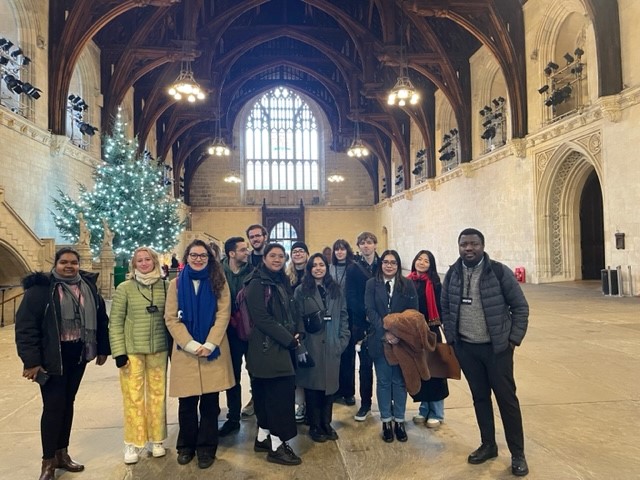Leo Hardwick, Student Immigration Compliance Reports Officer at Birkbeck, took part in a tour of the UK Parliament with 17 Birkbeck students, and in this blog he shares their experience.
We met, wind blowing, rain falling, next to the statue of Oliver Cromwell: dictator of England and Scotland. It had not yet gone 9am, and his stern, angry face was mirrored in the multitude of commuters, hurrying to their officers around Westminster, who were yet to have the sweet nectar of the first macchiato of the day.
We were the exception to this mood. A group of 17 Birkbeck students. From all over the world. Studying courses from Management to Art History. We were there for a tour of Parliament, organised by International Student Administration.
We met our tour guide in the main hall, the oldest part of the building – and one of the coldest rooms I have ever been in. The hall was the location for the trial of Charles I, who was sentenced to death for crimes against his people (over 100 years before the French repeated the exercise). We stood in the middle of the hall, where he had been seated, and felt the history.
What followed was a whistle-stop tour of British history, each room, each stone, witness to some of the most significant moments of our past. Our tour guide was excellent. Her enthusiasm infectious. First stop was the House of Commons, where MPs sit and debate. We brushed past the dispatch box: where Gladstone had fought Disraeli; where Asquith had told the nation of Britain’s entry into the Great War in 1914; where Churchill had made his famous speeches. We stood next to the bench Lady Astor, the first female MP to actually take her seat in the commons in 1919, had once sat.
The excitement was extinguished somewhat when the tour guide informed us that the chamber had been destroyed during the Second World War. Gladstone popped from view. That dispatch box had actually come from New Zealand…. And those benches, IKEA (well, maybe not). The bomb damage is still visible above the entry to the chamber.
We moved to the House of Lords. The carpet, and the benches, changed from green to red. The King’s throne haunts the Lords – he had been there a week earlier for the opening of Parliament. Some were taken aback that in this chamber sat the decedents of nobles who had come over with William the Conqurer in 1066. Products, like the King, of hereditary power. Even though the Commons once chopped off the head of a King – another Charles – the ancient regime lives. History lives.
The final stop was St Stephen’s Hall – where the Commons sat before the fire of 1834. This was the tour guide’s favourite room. This was where William Wilberforce had spoken out against slavery, and it was where, belatedly, slavery was finally outlawed. We were told that great things had happened in this space. As the tour guide explained, British political history seems to be a lesson, like it or not, in patience. Radicalism exists, but it is the product of forces that move like glaciers.
We finished our tour in the café, with cake and tea, and a sense of awe. A Birkbeck alumnus had once entered Westminster as one of the first MPs of the newly founded Labour Party, at the beginning of the twentieth century. He went on to become Labour’s first prime minister – Ramsay Macdonald. The illegitimate son of a housemaid, born into poverty, he represented real social mobility in Britain – his journey to the top had started in the corridors of Birkbeck, long before he swapped them for Westminster.
Further information

